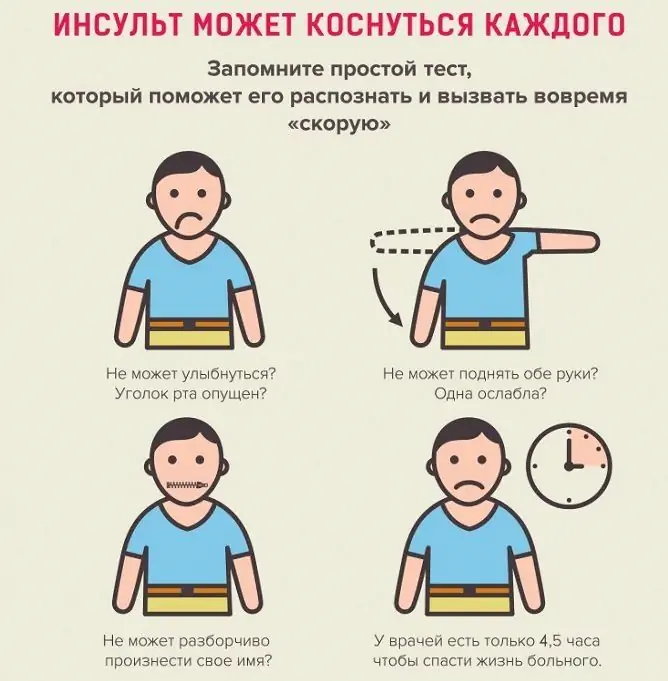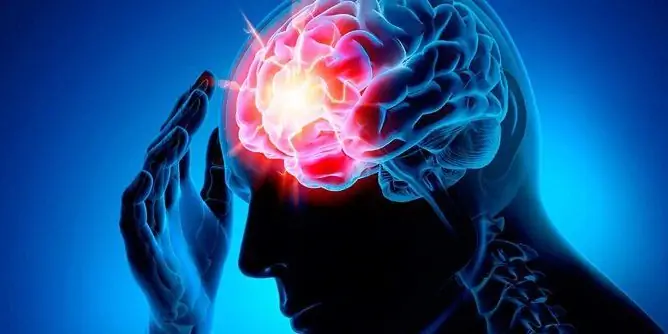- Author Rachel Wainwright [email protected].
- Public 2023-12-15 07:39.
- Last modified 2025-11-02 20:14.
Symptoms of sinusitis in adults: signs of the disease, how to treat
The content of the article:
-
Symptoms of sinusitis
- Headache
- Discharge from the nose with sinusitis
- Elevated temperature
- Local signs of inflammation
- General signs of intoxication
- Types of sinusitis and their characteristic signs
- Sinusitis treatment
- Video
Sinusitis is an inflammatory process in the maxillary sinuses of the nose. As a rule, the cause of its development is an infection that enters the nasal cavity from the outside or is carried by blood. The disease can occur in both women and men. An otolaryngologist is responsible for checking symptoms and treating sinusitis in adults and children.

You can determine sinusitis yourself by the typical symptoms of the disease
The reasons for the development of the disease include:
- injury to the nasal mucosa;
- advanced form of acute respiratory infections (acute respiratory disease);
- contact with the nasal mucosa of pathogenic bacteria or viruses;
- damage to the upper teeth by caries;
- hypothermia of the body;
- disorders of the immune system;
- mechanical damage to the nasal septum;
- allergy;
- disruption of the secretory glands;
- regular use of vasoconstrictor drugs.
Symptoms of sinusitis
In order to recognize the disease and start treatment on time, you need to know how sinusitis manifests itself.

With the appearance of characteristic signs, the onset of the development of inflammation in the maxillary sinuses of the nose can be assumed
A combination of signs such as swelling and nasal congestion, headache and deterioration in general condition may indicate the presence of an inflammatory process in the maxillary sinuses.
Headache
Headache is the first sign of sinusitis in adults. As a result of inflammation of the sinus mucosa, the channels between the nasal passages and the cavities overlap, which leads to the accumulation of contents, which gradually turns into pus and creates excess pressure in the sinus area. The headache with sinusitis is bursting in nature. Where does it hurt in this case?
The initial pain syndrome is observed in the area of the eyes and nose, gradually spreading to almost the entire face. At the initial stage of the disease, it is not so pronounced. Sometimes sinusitis is indicated by aching pains in the back of the head, which appear in the morning. As pus accumulates, they intensify and can be observed around the clock.

Headache is one of the leading symptoms of the disease
The pain becomes sharp and throbbing, more pronounced when bending or turning the head. Short-term spasms may appear, which are localized near the root of the nose. It is also possible to increase it if the patient takes a horizontal position and the swelling in the sinuses increases.
In the later stages of sinusitis, the pain practically does not stop. It is difficult to stop it with drugs. After taking pain relievers, pain is dulled for a short time, then resuming with renewed vigor.
In a small number of patients, headache occurs not only during an exacerbation of the disease, but also persists after the treatment of sinusitis is completed. The reason for this may be the transition of the process to a chronic form, the presence of complications or a low individual pain threshold. In some cases, during a puncture, damage to one of the nerve bundles is possible, which leads to the appearance of headaches or causes the development of vegetative vascular dystonia.
Discharge from the nose with sinusitis
In most cases, sinusitis is accompanied by profuse nasal discharge. As a result of the inflammatory process, mucus, pus, or blood clots accumulate in the paranasal sinuses.
The color of the discharge depends on the stage of the disease:
- white or transparent. They appear when the disease begins and are thin in consistency. Before recovery, the discharge may become thick;
- green. Indicate an acute form of the disease;
- yellow or yellow-green. Indicate the presence of pus in the sinuses. They are often a sign of catarrhal sinusitis. The mucus is thick, viscous, with an unpleasant odor, after drying it turns into crusts;
- bloody. Observed in severe disease, which requires immediate treatment.
An untreated runny nose often leads to the development of sinusitis, so you need to pay attention to a change in the nature of nasal discharge, and if you have pus or other signs, you should consult a doctor.
Elevated temperature
Fever is often a symptom of sinusitis in adults. It indicates the onset of the inflammatory process and that the immune system has been activated against the pathogenic bacteria that caused the development of the disease.

The disease is often accompanied by an increase in body temperature
In the initial stages of inflammation, slight fluctuations in body temperature are usually observed. In the acute form of the disease, it can rise to 39 ° C, which requires the use of antipyretic drugs.
Local signs of inflammation
Sinusitis is most often accompanied by the following local signs of inflammation:
- unpleasant aftertaste after eating;
- swelling in the eyes, cheeks or nose (this is noticeable even in the photo of a patient with sinusitis);
- violation of smell (the patient completely or partially ceases to react to odors);
- increased lacrimation and sweating;
- change in the timbre of the voice, the appearance of nasalness;
- bad breath or nose.
The appearance of one or more of these symptoms is a reason to seek medical advice.
General signs of intoxication
What is intoxication? This is a general reaction of the body to the introduction of pathogenic microorganisms. The condition is characterized by the following general features:
- weakness: the patient becomes lethargic, gets tired quickly even after little physical exertion;
- apathy: the patient ceases to actively respond to external stimuli;
- sleep problems: insomnia at night and sleepiness during the day.
Symptoms of intoxication can develop in both acute and chronic forms of the disease and indicate not only the presence of sinusitis, but also indicate other diseases.
Types of sinusitis and their characteristic signs
Depending on the causes and localization of inflammation, the following types of sinusitis are distinguished:
- Catarrhal. It is rarely diagnosed in adults. Its signs include a slight increase in body temperature, lethargy, weakness, and lack of appetite. In patients with catarrhal sinusitis, signs of intoxication are revealed and performance decreases.
- Double sided. The disease is accompanied by symptoms such as fever, headaches, congestion and severe mucus from the nose, watery eyes. Efficiency decreases, lethargy and sleep disturbances are noted.
- Sharp. In this case, the symptoms of the disease are pronounced. There are severe headaches and pain in the sinuses, purulent mucous discharge from the nose, swelling of the mucous membrane. Also, with acute sinusitis, the temperature rises, breathing becomes difficult, and the ability to work is impaired.
- Chronic. This form of the disease develops with improper or untimely treatment of acute inflammation. At the same time, the symptoms of sinusitis in adults are lubricated, there may be a slight runny nose and nasal congestion. Lethargy, apathy, disability are possible. With a relapse, the patient develops the same symptoms as in the acute form of the disease.
Sinusitis treatment
Symptoms of sinusitis in adults cannot go away on their own. In order to avoid the development of complications, timely and adequate therapy is required. It is very difficult to get rid of the disease at home. Improper treatment can lead to the fact that the inflammatory process becomes chronic and will periodically worsen.

To check the symptoms and prescribe adequate therapy, you need to contact the ENT
How is the disease treated? In most cases, antibiotics are used in the treatment of sinusitis. Select agents with a wide spectrum of action that are active against most bacteria that cause disease.
The doctor determines the drug, treatment regimen and duration of use. In milder forms of sinusitis, drugs are prescribed in the form of tablets or suspensions. In severe cases, parenteral antibiotics are used.
In the complex treatment of the disease, vasoconstrictor drops are used. They allow you to restore nasal breathing and promote the outflow of contents from the maxillary sinuses. The active substance of such drops is xylometazoline or oxymetazoline.
As an additional treatment, drugs of the following groups are used:
- Mucolytics: allow to reduce the viscosity of sputum and promote its evacuation from the maxillary sinuses.
- Immunostimulants: stimulate the body's nonspecific resistance and immunity, which speeds up recovery.
- Non-steroidal anti-inflammatory drugs: reduce inflammation and relieve headaches.
For rinsing the nose, ready-made saline solutions (Salin, No-salt, Sodium chloride) can be prescribed. Antiseptics (Miramistin, Furacilin, Dioxidin) are also used in the treatment of sinusitis.

The inflammatory process helps to reduce the decoctions of medicinal herbs used to wash the nasal cavity. The most effective are funds based on chamomile, calendula or oregano. A small amount of raw materials is poured with water, boiled, and filtered after cooling.
Folk remedies are used in the chronic form of the disease, when the symptoms of sinusitis in adults are not too pronounced. The most popular and effective of them include special mixtures that accelerate the outflow of contents from the maxillary sinuses. For cooking, use brown laundry soap, wax, honey, onion juice, aloe juice. They are mixed and melted in a water bath. Then the mixture is applied to a tampon and injected into the nasal cavity. Within a short period, the contents begin to flow out of the sinuses.
One of the reliable and effective remedies for the treatment of sinusitis is cyclamen root juice. It affects the receptors of the nerves, thereby stimulating secretion, which makes it possible to reduce swelling and bring pus out. Cyclamen juice is the active ingredient of the commonly used drug Sinuforte.
Signs of sinusitis in adults can be quite varied. The ENT will help to identify what exactly caused the appearance of headaches and nasal congestion after an in-person consultation and passing the appropriate tests.
Video
We offer for viewing a video on the topic of the article.

Anna Kozlova Medical journalist About the author
Education: Rostov State Medical University, specialty "General Medicine".
Found a mistake in the text? Select it and press Ctrl + Enter.






